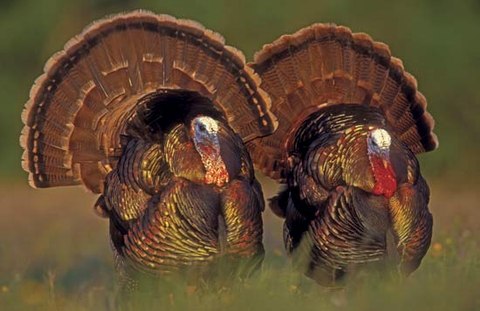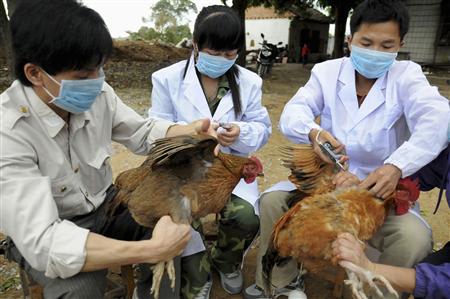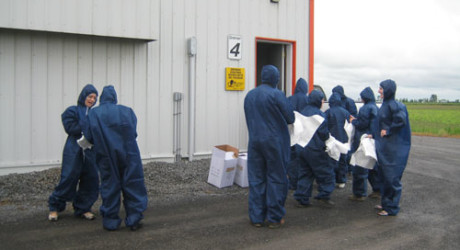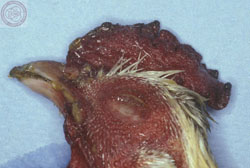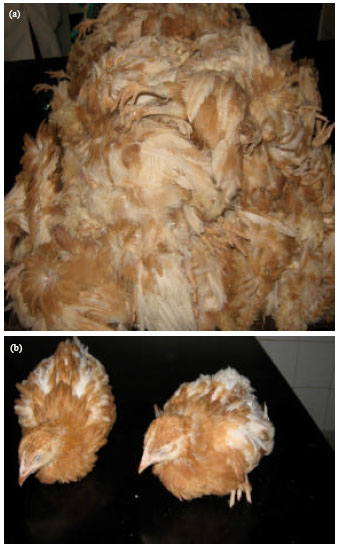
Poultry,
like all animals, need energy for production and maintenance. There are
two different ways of estimating the energy requirement of poultry: AME
N (Apparent metabolizable energy, nitrogen-corrected) and TME
N
(True metabolizable energy, nitrogen-corrected). The first is used in
Europe, the latter in the USA. Both rely on metabolizable energy - the
amount of energy gained from feed and not excreted in feces. The
difference is that TME
N takes into consideration the endogenous excretion of nitrogen, and thus gives more accurate energy estimates.
Poultry
regulate their intake of feed based on the energy content of the feed.
The higher the energy count, the less they eat. It is important to
ensure that chickens eat enough to get all the required nutrients from
their feed. Gaining body fat is not a problem in today's poultry breeds,
which are bred for extremely high growth and efficiency. Egg-laying
chickens require ~500 kJ / day for maintenance, or 770-840 kJ ME/day.
Each kilogram of eggs produces requires 11,2 kJ ME. Young egg-laying
hens need additional 10 kJ a day for their own growth.
Methods of determining energy content
 |
| Chickens in balance cages (c) ILVO |
There are three methods for determining the energy content of poultry feed. The traditional method
CAM
is used to determine apparent metabolizable energy. Birds of all ages
can be used, but usually this is done using mature roosters. The birds
are held alone in collection cages (balance cages), which enable the
scientists to measure exactly the amount of food eaten and feces/uric
acid excreted. First the birds are 1-6 days in the cage just getting
used to the test feed (1 day is enough for chickens). The collection
period lasts for 3-4 days, during which feces and uric acid are
collected and analyzed several times a day. This method is painless for
the animals and allows determining the digestibility of the feed at the
same time, but is very labour-intensive and take a lot of time.
The
Farrell method
is a more rapid determination of ME. In the beginning and end of the
collection period, the animals are denied food to increase the
reliability of the test results. Farrell method uses only experienced
test animals, which are able to eat high amounts of test feed in one
hour. 24 or 36 hours after the animal has eaten ,the feces (including
the uric acid) are collected and analyzed. The Farrell method is a lot
faster than CAM, and requires the animals to spend only a short time in
the balance cage. However, fasting is unnatural for poultry, which may
raise welfare concerns.
The third method is the
Sibbald method.
Unlike Farrell and CAM, Sibbald is used to determine the true
metabolizable energy. The animals are kept on a fast for 24 hours before
the trial to empty their digestive tract. The test feed is then
force-fed through a tube directly into the crop of the birds. 25-50
grams of feed is inserted at one time. Feces are collected 24 or 48
hours after the force-feeding. To determine endogenous excretion of
nitrogen, the trial is repeated several times, and each time one animal
is not fed at all. The results for that animal show the level of
endogenous excretion. While the Sibbald method is fast, reliable and
enables studying all kinds of feeds, it raises severe welfare concerns
due to fasting and force-feeding.
Amino acids
Like mammals, poultry need to get necessary amino
acids from their feed. Young chickens need amino acids more than older
ones, since their growing feathers, meat and bones require a lot of
protein. The most needed amino acid is lysine. Young chickens need
lysine 9,5 g/kg. Because poultry regulate their intake of feed based on
the energy content, it is important to make sure they eat enough to get
the needed proteins. To estimate this a ratio between energy content and
amino acids is calculated:
amino acid content / energy content = AA/energy ratio
For
a 6 week chick the ratio should be 155-160 g / 10 MJ, 165-180 g / 10 MJ
for a meat chickens and 140-150 g/10 MJ for egg-laying hens. The feed
for chicks younger than 6 weeks should have 200 grams of protein / kg
dry matter.

Poultry
can only use amino acids which are absorbed from the small intestine.
Indigestible and endogenous amino acids are microbially transformed into
ammonia in the caecum. The ammonia, which is useless for the animal, is
excreted in uric acid. An egg-laying hen aged 35 weeks may eat 2500 mg
of nitrogen, of which over 1000 mg is excreted in feces, and a bit less
than 1000 mg used in eggs. This leaves only a few hundred mg of nitrogen
for the animal itself. Eggs contain 12,5 % protein. When the hen lays
one 50-70 g egg a day, she needs 10-17,5 g of protein daily. If the
protein content of the feed is not high enough, the hen will stop laying
eggs. The protein need depends on the breed of the animal, phase of
producction, type of housing, health, energy content of feed and the
feeding method.
The ideal protein for poultry is a bit
different for meat chickens and egg-laying hens. Lysine is the most
important amino acid for both. Layers need more amino acids than meat
chickens. The exceptions are histidine, leucine, phenylalanine and
tyrosine, which are more important to meat chickens than layers. Layers
need amino acids in relation to their weight and egg production
capability. For example, a layer needs 9,99 mg lysine a day / g of eggs
produced, and further 73 mg / weight in kg. A 2 kg chicken laying one 60
g egg would thus need 9,99*60 + 73*2 = 745,2 mg lysine / day.
Meat
chickens should be fed in phases to optimize their utilization of
lysine. The need for lysine decreases as the meat chicken grows, so each
feeding phase can contain less lysine. Optimizing feeding for meat
chickens and layers decreases feed costs and waste of nitrogen.Varying
the phase feeding lengths for meat chickens can increase the weight at
slaughter over 150 grams, and decrease the amount of abdominal fat 0,5
%.
Studies show that optimizing poultry feeds based on
amino acids is more reliable than optimizing based on metabolizable
crude protein. Optimizing amino acids can produce 18-24 % less nitrogen
in feces and better utilization of amino acids in the feed.
Minerals
Egg-laying hens have strict requirements for minerals in their daily feed. Lack of minerals in the beginning of the laying season may affect productivity for the rest of the season. Layers need especially
- Calcium: needed for bones and egg shells. Calcium is important for chickens of all ages.
- Phosphorus: calcium and phosphorus must be in the right balance for either to work. Phosphorus is also important for vitamins and cell metabolism.
- Magnesium: activates enzymes in energy metabolism, and builds up nerves and bones. Magnesium is said to have a calming effect on chickens.
- Sodium: Balances the nervous system and pH
- Chloride: Balances the fluid balance of the body, is needed for gastric juices
- Potassium: A balancing factor
- Sulphur: Important for building sulphur-based amino acids, and for healthy feathers
Chickens also need the following macrominerals: iron, copper, iodine, manganese, zinc, selenium. The most important mineral, however, is calcium. Each day a hen loses 2-2,5 grams of Ca as she lays an egg. The recommended daily amount is 35 g Ca/kg feed, or 4 g / hen / day. A high amount of Ca in the daily diet improves the strength of the egg shell, but amounts of over 2,5 g gradually decrease the absorbancy of Ca. Chickens do not eat during the night (dark period), so Ca is absorbed from bones. Therefore slowly digestible Ca source is recommended. Also the coarser the Ca powder in the feed is, the stronger the chicken bones are. Coarseness of Ca has no impact on egg shell strength.
When the egg shell forms, calcium ions are combined with HCO
3-. HCO
3- is originally created from water (H
2O) and carbon dioxide, CO
2. When the Ca
++ and HCO
3- are mixed, a nitrogen is lost and the resulting CaCO
3 creates a sturdy, white egg shell.
Phosphorus and phytic acid are important in maintaining good layer productivity. In one study a feed with 3 g P/kg and no added phytic acid results in a laying rate of 92,4 %, egg weight of 56,8 g and dry matter content of the tibia of 4,19 g. The same feed with 460 units of added phytase resulted in a laying rate of 95 %, egg weight of 58,4 g and dry matter content of the tibia of 4,87 g. Another study has proven that adding phytase increases the utilization of inorganic phosphorus, but do not improve the apparent ileal digestivity of P. Added phytase also increases the mineralization and tensile strenght of bones.
 |
| (c) unknown |
Feeds
Chickens are usually fed either with a complete feed or concentrated feed + grains. Complete feeds include everything the birds need: minerals, proteins, energy, fats and calcium. It is an easy but expensive alternative. Using concentrated feed and grains requires more planning, but can be cheaper if home-grown grains can be used. All ingredients must be analyzed to ensure their correct balance in the feed, and mixed well. The ratio of ingredients must be changed throughout the growth/egg-laying period as the requirements of the animals change.
In Northern Europe, the most important ingredients in poultry feeds are barley and oats. They contain noticeably less energy than soybeans and corn, which are commonly used in the USA and elsewhere. Vegetable oils can be added to the grains to increase the energy content, because poulty cannot eat very much at one time, and will lose weight if the feed is too low in calories. 70-80 % of the energy in grains is metabolizable, because the energy in grains is mostly starch. Wheat has 65 % of starch, barley 55 % and oats 40 %. Poultry can metabolize starch almost entirely.
Wheat has 12,5 MJ/kg ME and 12-13 % of proteins. Wheat can be used for adult meat chickens and layers, but is too strong (the energy content is too high) for young birds. Wheat has only little lysine.
Barley is the most used grain in poultry feeds. It has 11,5 MJ/kg ME and 12 % protein, which makes it less strong than wheat, and thus better suitable for poultry of all ages. However, the betaglucans in barley reduce the digestibility of all nutrients, and may cause sticky feces. Adding betaglucanase-enzyme to the feed eliminates this problem.
Oats have only 10-11 MJ/kg ME due to a high content of crude fibres. Oats also have twice the amount of fats than other grains, and more lysine than barley. Oats are mostly used for chicks and growing chickens, but high-quality oats can also be used to replace barley for layers and meat chickens. For layers, oats and barley are interchangeable.
By-products of grain processing, such as brans and barley flour can also be used.
By-products of alcohol production have too little energy to be of value to poultry.
Soybean meal has 50 % of protein and much lysine, but it has to be supplemented with methionine. Soy can be used for meat chickens.
Rapeseed meals (canola) are the "left overs" from the production of rapeseed oil. Depending on the oil production method, rapeseed meals contain 2-10 % fat and roughly 8 MJ/kg ME. The protein content is similar to soybean meals, but is less digestable. If the rapeseed used contains no erucic acid, sinapic acid or glucosinolates, rapeseed meals can be used to replace soybean meals entirely. However, in one study canola meals were found to decrease egg-laying percentage and egg weight.
Peas and
broad beans have some antinutrients, such as oligosaccharides (pea), visine and convisine (broad bean). Visine and convisine cause aplastic anemia, which is uncurable and lethal to chickens. The amount of visine and convisine in broad beans cannot be reduced in feed processing. Peas have 20-22 % of protein and broad beans 26-28 %, and both have a lot of lysine but little methionine. Due to the antinutrients, the feed of layers can have up to 30 % peas and 5 % broad beans.
Fish meal is used for chicks in small amounts. Adult layers and meat chickens develop a fishy taste and smell to eggs and meat if fed fish meals.

 The rearing is mostly automatized. Ventilation, temperature and humidity control, feeding, watering and light programming are all automated. While it saves work, even relatively short power outages can kill the entire flock to suffocation due to rapidly raising levels of ammonia, H2S and CO2 in the air. Because the light/dark program is carefully designed and obeyed, broiler halls have no windows or any inlet for daylight (organic farms are an exception). Meat chickens are still manually inspected twice a day. The farmer ensures all the automated systems work, and that the litter is dry and clean.
The rearing is mostly automatized. Ventilation, temperature and humidity control, feeding, watering and light programming are all automated. While it saves work, even relatively short power outages can kill the entire flock to suffocation due to rapidly raising levels of ammonia, H2S and CO2 in the air. Because the light/dark program is carefully designed and obeyed, broiler halls have no windows or any inlet for daylight (organic farms are an exception). Meat chickens are still manually inspected twice a day. The farmer ensures all the automated systems work, and that the litter is dry and clean. 
